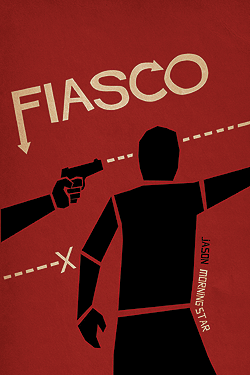FIASCO: an award-winning story-telling game inspired by cinematic tales of small-time capers gone disastrously wrong, now at your friendly local game store! You’ll tell a story about ordinary people with powerful ambition and poor impulse control. Lives and reputations will be lost, painful wisdom will be gained, and maybe, just maybe, you’ll end up right back where you started. You probably won’t be that lucky.

Every other Friday night, join us in our new lounge area to craft a disastrous story filled with characters from all walks of life. FIASCO is a rules light system, making it perfect for prospective roleplayers to really get into character. Not to mention that each event has a different theme, so if one week doesn’t tickle your fancy, no worries! Check the Meetup again in a couple of weeks for the next type of story.
There are 5 parts to a FIASCO game: the Setup, Act 1, The Tilt, Act 2, and the Aftermath. Before each game players will choose certain aspects of their characters and story from various playsets, which will guide the rest of the game. In FIASCO there are no skill checks, and players haver a lot more control over their actions than most other RPG’s. For a more in-depth overview, check here or keep on scrolling!

Setup
During setup, players will select Objects, Needs, Locations, and establish Relationships with the neighbors to their left and right, choosing everything from a list from the playset. You will need to define your relationships, but everything else is optional. You could share multiple locations with your neighbors, or maybe you just share one. You don’t even have to fully expand on them before the game starts, these are just to give you ideas about your characters role in the story.
It’s important to remember that everything – even your Needs, Objects, and Locations – are shared between you and a neighbor. That means if you take the location Suburban Home, you could turn it into My mother-in-law’s suburban home that she’s reluctantly letting me stay at, going off of your pre-established relationship with your neighbor as your mother-in-law. However, locations can be shared with everyone at the table – they’re just a focal point for the two characters that share it. Once everything is established and you’ve put your own twist on it, you’re ready to get into Act 1, where everything seems to be going to plan.

Act 1
Welcome… to Act 1. Here, the ball really gets rolling, the plans start unfolding, and all hell breaks loose. Players will take turns either Establishing Scenes or Resolving Scenes until half of the dice from the pool are gone.
When Establishing a Scene, a player decides where a scene takes place, and who’s participating. And remember – there are no die rolls at this point, players have total control over what happens, so make it interesting! About halfway through, the players not in the scene decides whether the scene ends well or poorly, selecting a light colored or dark colored die respectively, at which point the participating players resolve the scene accordingly. The active player will then take the dice and pass it to another player.
Alternatively, a player can Resolve a Scene, where they select the dice color beforehand, and the other players establish the scene and situation.

The Tilt
Alas, all good things must come to an end, and pretty soon the characters good luck must come to an end as well. This is represented by the dreaded tilt, the next step after half of the dice from the pool are distributed throughout the players. During the Tilt, the players with the most light-colored dice and the most dark-colored dice will each pick the elements from the Tilt Table, which will provide a twist or unexpected condition on the story. These can range from “someone panics”, “two people cross paths and everything changes”, and even “magnificent self-destruction”. Two Tilts will be selected and then incorporated into the story, so that everyone is on the same page to bring this fiasco to fruition. Who will panic, and what caused it? Whos going to meet? Will it change things for the worse or better, and for who? How will the magnificent self-destruction trigger? These are just some basic questions that give players an idea with how to proceed into Act 2.
For example, everyone agrees that Sydney, who just acquired a highly illegal substance, will probably be the one who panics due to her paranoia of being found out. How will it end up? That’s for Act 2 to tell, but at least players won’t be clashing over any differing ideas. Once everyone is one the same page, it’s time to unravel the twist and see just how much a fiasco this story will turn out to be.

Act 2
Act 2 is where things really start to unravel, as all the characters must now reckon with the tilt. Will their drug-empire suddenly collapse? A new business prospect lost due to a fatal mistake? Maybe they’ll lose all their friendships, get sucked deeper in that squirrel cult, or even fail their mid-term exam. No matter what crazy twists and developments happen, it’s important to remember that your story does NOT resolve in Act 2, so you have to leave it a little open-ended. This is only the beginning of the end.
Another important distinction is that rather than giving the dice your scene got to another player, you must now keep all of our dice. If your scene had Bad Ending, looks like you’re stuck with that Bad Dice. However, now you get to keep all of the Good Dice that you rightfully earned.

Aftermath
Well, this is it. The end of the line, the last stand, the final showdown. Well, maybe not that dramatic. But, this is the end of the game. Now, you’ll get to use all of the dice you earned, and you’ll quickly find out that it’s better to have all good or all bad dice.
During the aftermath, you will roll all of your dice, adding them together treating the Good Dice numbrs as positives and the Bad Dice numbers as negatives. For example, if I had rolled 2 Good Dice with a total of 6 and two Bad Dice with a total of 8, the result would be -2 (Or Bad Side 2). Then, you’ll refer to the list of endings and find the one corresponding to your total. This tells you how you faired after the events of Act 2, 0 being the worst and 10+ being the best. Now you can wrap up your story – did you become president like you wanted to, or are you in prison sharing your intense love of Beethoven with others? You will spend each remaining dice you have narrating a scene with your character, and then – That’s it! Your Fiasco is (for your characters, thankfully) over, with only tales left to tell of such a sequence of events.

